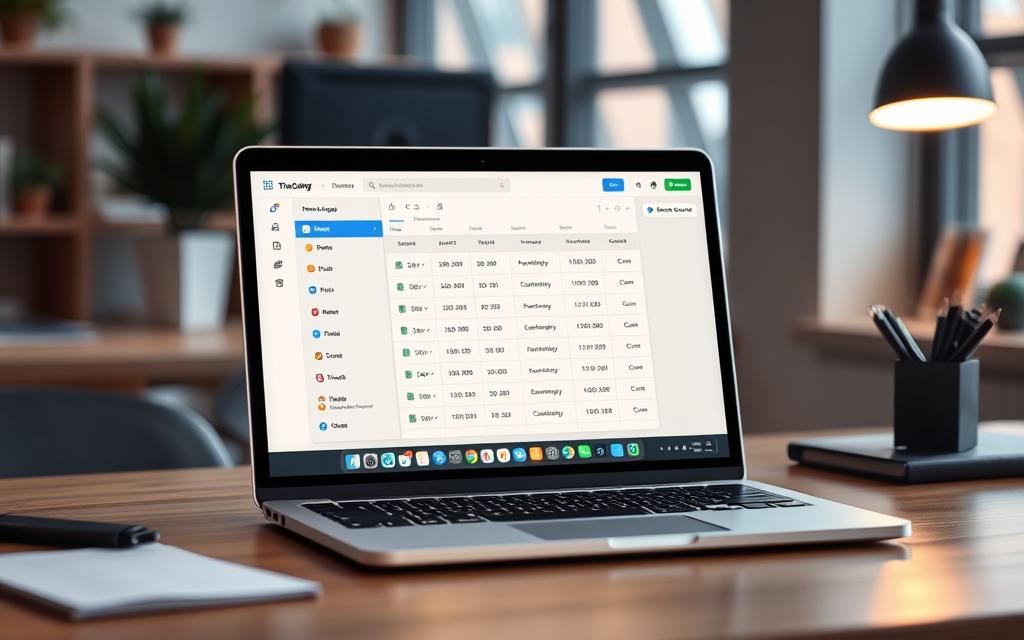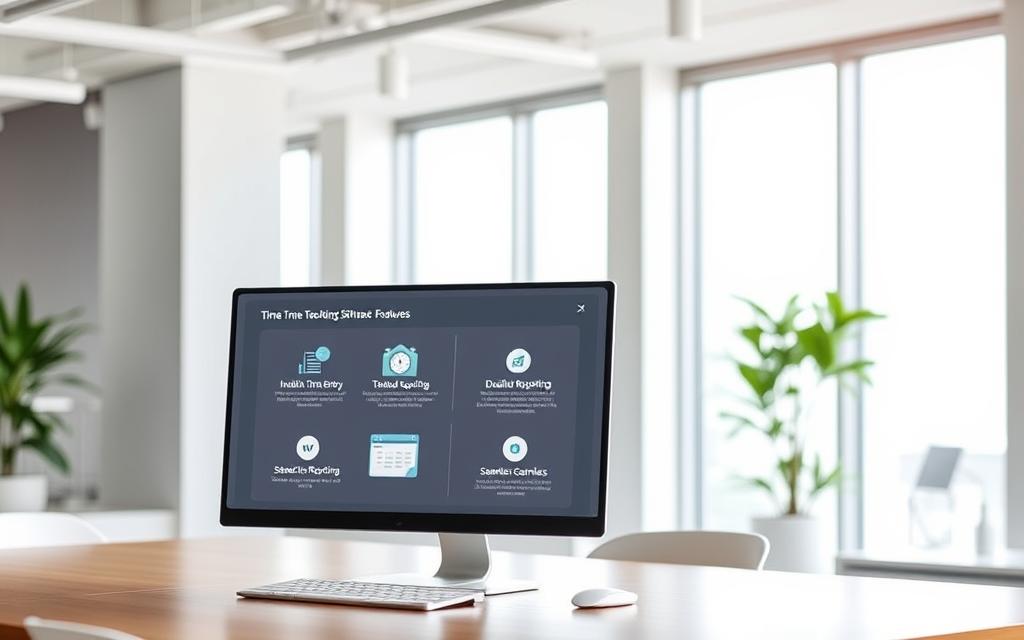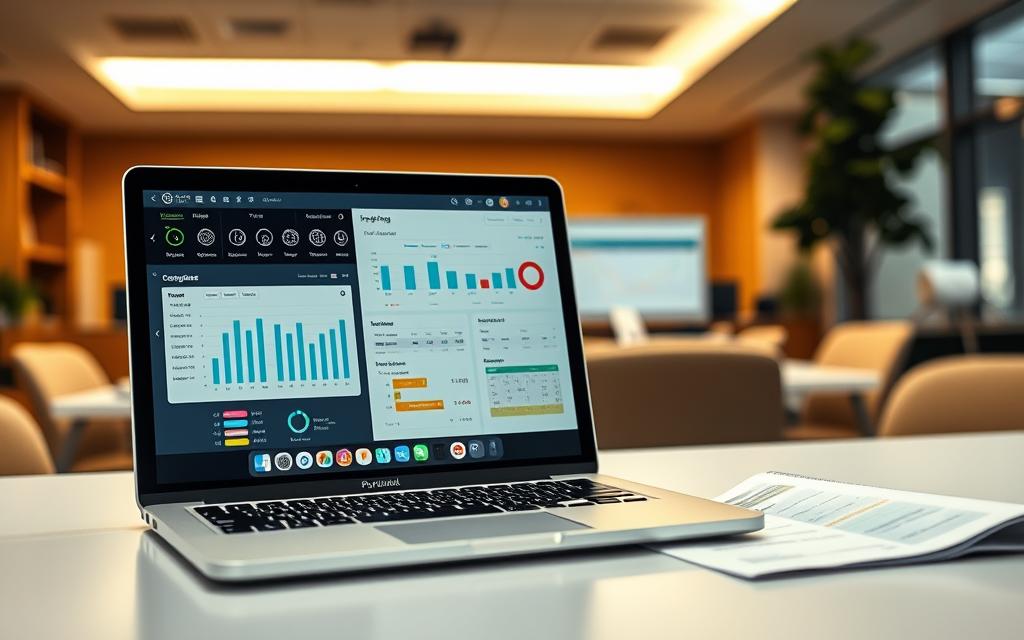Managing workloads effectively is essential for growing teams, and structured productivity methods like the Pomodoro Technique prove how intentional time management drives results. For organizations aiming to streamline operations, modern tools now simplify logging work hours while improving accountability.
This guide explores practical solutions tailored for lean teams. Whether you prefer automated systems or manual logs, the right approach ensures accurate payroll, compliance, and data-driven decisions. We’ve tested platforms like Paymo, Toggl Track, and Clockify – tools designed to adapt as your needs evolve.
With over 15 years of industry experience, our analysis combines hands-on testing with insights from businesses like yours. Paymo’s journey from basic timesheet software to a comprehensive project hub, for example, reflects how adaptable these tools have become.
You’ll discover actionable comparisons to identify the best time tracking fit for your workflow. From reducing administrative tasks to spotting inefficiencies, the right strategy turns hours into opportunities. Let’s dive in.
Introduction to Time Tracking for Small Businesses
Long before digital tools streamlined operations, companies relied on manual methods to monitor work hours. Early systems like punch cards and paper logs dominated workplaces, requiring tedious calculations and leaving room for human error. These foundational approaches, however, laid the groundwork for today’s automated solutions that blend precision with versatility.
The Evolution of Time Tracking in Small Companies
In the 20th century, mechanical time clocks revolutionized how organizations recorded attendance. Employees inserted physical cards stamped with their arrival and departure times. While innovative for their era, these systems couldn’t handle complex tasks like project-based billing or real-time productivity analysis.
Modern platforms now integrate GPS location checks, automatic timesheet generation, and invoice synchronization. This shift from analog to digital tools eliminated guesswork in payroll processing and empowered teams to focus on strategic priorities. For instance, a landscaping company might use mobile-friendly software to track crew hours across job sites while automating client billing.
How Time Tracking Boosts Overall Productivity
Accurate data transforms how teams operate. By analyzing logged hours, managers identify bottlenecks, redistribute workloads, and set realistic deadlines. A marketing agency could discover that creative tasks take 30% longer than estimated, prompting adjustments to project timelines.
Adopting timesheet software also reduces administrative burdens. Automated reminders ensure employees submit hours promptly, while centralized dashboards provide instant visibility into team availability. These features align with findings from a comprehensive guide, which highlights how streamlined logging improves accountability across departments.
Understanding the Importance of Accurate Time Logging
Mistakes in logging work hours can lead to costly payroll errors and compliance headaches. Even minor discrepancies add up, creating financial risks and straining team trust. Automated systems like Paymo Track tackle these challenges head-on by capturing data accurately without invasive screen monitoring.
The Impact on Payroll Accuracy and Compliance
Manual timesheets often result in overpayments, underpayments, or missed overtime calculations. For example, a retail team might lose hundreds monthly due to misrecorded breaks. Modern apps sync with labor laws, flagging potential violations before paychecks go out. Paymo Track’s approach skips controversial screen captures while maintaining precision, addressing privacy concerns common in hybrid workplaces.

Improving Operational Efficiency Through Precise Data
Dedicated apps eliminate guesswork by auto-generating timesheets and project reports. Managers gain insights to redistribute tasks or adjust deadlines based on real-time data. A design studio using these tools might cut administrative work by 40%, freeing staff for creative priorities. Over time, refined schedules boost productivity metrics across departments.
Organizations prioritizing accurate logging see fewer payroll disputes and faster project completion. This reliability builds client confidence and positions companies for scalable growth without compliance roadblocks.
Small Business Time Tracking: Key Strategies for Success
Choosing the right system for logging hours transforms how teams operate. To maximize value, focus on tools that simplify workflows while delivering actionable information. Let’s explore how to prioritize features and connect them to your objectives.

Defining Essential Features in Your Time Tracking Software
Look for platforms that balance automation with flexibility. For example, Paymo’s native auto-tracking runs quietly in the background, capturing active work without manual input. This reduces errors and ensures every billable minute counts.
Key features to prioritize:
- One-click timers for quick task switching
- Customizable reports showing weekly trends
- Integration with project management dashboards
Toggl Track excels here with its cross-device syncing, letting remote teams update entries from anywhere. These capabilities turn raw data into strategic information for decision-making.
Aligning Time Tracking With Business Goals
Connect your software choice to specific outcomes. A consulting firm might automate client invoicing to shorten payment cycles, while a development team could analyze weekly sprint data to refine estimates.
Paymo’s project billing integration demonstrates this alignment. Hours logged directly populate invoices, eliminating duplicate entries. Over six weeks, one agency reported a 25% drop in administrative tasks after adopting this approach.
Regularly review reports to spot patterns. If creative tasks consistently overrun deadlines, adjust timelines or allocate additional resources. This proactive use of data turns time tracking software into a growth accelerator.
Key Benefits of Automated Time Tracking
Automating time tracking isn’t just a trend—it’s a strategic shift reshaping how teams operate. By replacing error-prone spreadsheets with intelligent systems, organizations gain precision while freeing up resources for core tasks.

Reduction of Manual Errors and Time Wastage
Manual data entry often leads to miscalculations that ripple through payroll and client billing. Platforms like Paymo Track and RescueTime eliminate these risks by capturing hours in real-time. Studies show teams using automatic logging reduce timesheet corrections by up to 90%.
Key advantages include:
- Precision: Systems sync with digital calendars and tools, ensuring every minute is recorded accurately.
- Compliance: Built-in labor law alerts prevent costly oversights in overtime or break calculations.
- Efficiency: Automated reports slash administrative work, letting leaders focus on strategic priorities.
Integrating project management features further streamlines workflows. For example, tagging hours to specific tasks provides clarity on resource allocation. This alignment between logged data and operational goals, as highlighted in productivity analyses, turns raw numbers into actionable insights.
Reviewing Top Time Tracking Tools for Various Needs
Every team has unique requirements when logging hours. Whether invoicing clients or coordinating field crews, the right platform simplifies daily workflows while aligning with operational priorities. Let’s compare three leaders in this space.

Robust Invoicing for Collaborative Teams
Paymo stands out for teams needing seamless billing integration. Its tools auto-convert logged hours into invoices, reducing manual data entry. With customizable templates and tax settings, agencies report cutting billing cycles by 35%. Pricing starts at $11.95/user monthly, ideal for groups prioritizing financial accuracy.
Users praise Paymo’s 4.7/5 Capterra rating, noting how project time tracking data syncs with budgets in real-time. A marketing team handling 50+ monthly clients saved 12 hours on administrative tasks after adopting this system.
Streamlined Functionality for Independent Workers
Toggl Track appeals to freelancers with its minimalist design. The one-click timer works across devices, making it easy to switch tasks during coffee shop work sessions. Its free plan supports solo users, while paid tiers ($10+/user) add project dashboards.
Freelancers highlight Toggl’s intuitive reports showing based hours worked per client. A graphic designer doubled her billable rate by identifying undercharged projects through weekly analytics.
GPS Solutions for On-the-Go Crews
Clockify caters to mobile teams needing location verification. GPS stamps confirm site arrivals, while offline mode ensures rural connectivity. The free version includes basic features, with advanced plans ($4.99+/user) offering geofencing alerts.
Construction managers using Clockify reduced payroll disputes by 60% through automated tracking software logs. Real-time maps help dispatchers reroute crews based on proximity, optimizing daily routes.
Integrating Time Tracking with Project Management & Payroll
Modern teams thrive when tools communicate effortlessly. Connecting time-tracking software with project dashboards and payroll systems eliminates redundant data entry while boosting accuracy. This synergy transforms raw numbers into actionable workflows, letting organizations focus on growth instead of administrative chaos.

Seamless Invoicing and Reporting Benefits
When logged hours auto-populate invoices, billing cycles shrink dramatically. A digital marketing agency reduced invoice preparation from 6 hours to 45 minutes by syncing their project management platform with payroll tools. Real-time reports also help spot trends, like recurring overtime on specific tasks, enabling proactive adjustments.
Ensuring Smooth Data Flow Between Systems
API-driven integrations prevent data silos that plague manual processes. Paymo’s API, for example, automatically pushes approved timesheets to accounting software, removing version control issues. Third-party connectors like Zapier bridge gaps between niche platforms, ensuring compatibility even with legacy systems.
Common challenges include mismatched field formats and delayed syncs. A construction firm solved this by using middleware that standardizes data before transferring it between apps. Teams adopting advanced integration strategies report 50% fewer payroll discrepancies and faster client payments.
Measurable outcomes matter most. One logistics company cut timesheet processing by 70% after unifying their tools, redirecting 15 weekly hours to customer service improvements. These wins highlight why interconnected systems aren’t optional—they’re essential for scalable operations.
Leveraging GPS and Automated Features for Modern Workforces
Technology bridges the gap between dispersed teams and seamless operations. For crews working beyond office walls, GPS-enabled systems like Clockify provide real-time visibility into location-based tasks. This shift eliminates outdated “check-in” routines, replacing them with precision tools that adapt to dynamic workflows.

Benefits of Location Tracking and Auto Reminders
Field service teams gain the most from GPS verification. A landscaping company reduced scheduling conflicts by 45% after adopting geofencing alerts. Crews receive automated notifications when approaching job sites, ensuring punctuality without micromanagement.
Auto reminders also combat inconsistent logging. Employees receive prompts to start/stop timers or submit timesheets, reducing late entries. One logistics firm saw 80% fewer payroll errors after implementing these nudges.
Enhancing Accountability in the Workforce
Transparency builds trust in hybrid environments. Managers view verified hours worked alongside location stamps, addressing discrepancies proactively. A delivery company using these management features improved on-time rates by 30% while cutting fuel costs through optimized routes.
Modern platforms sync data across devices, letting off-site teams update entries from tablets or phones. Real-time dashboards display work hours and task progress, fostering ownership without invasive surveillance. As noted in industry analyses, this balance between autonomy and oversight drives long-term engagement.
Monitoring Employee Productivity with Advanced Tools
Modern workplaces demand transparency without sacrificing trust. Advanced monitoring systems now offer granular insights into work patterns through features like periodic screen captures and desktop activity logs. Tools such as Time Doctor blend automated time tracking with optional screenshot recording, giving managers visibility while addressing privacy concerns.
Balancing Precision With Privacy
Screen capture tools take random snapshots during active work hours, helping verify billable tasks. A marketing agency reduced client disputes by 40% using this approach to confirm campaign development timelines. However, intensive monitoring can fuel anxiety if not implemented thoughtfully.
To maintain trust:
- Disclose monitoring scope during onboarding
- Allow employees to blur sensitive screens
- Use activity logs instead of screenshots for performance reviews
Time Doctor’s controversial always-on recording mode sparked debates about remote work surveillance. Many teams now opt for lighter tracking app features like keyboard activity metrics, which measure engagement without visual intrusion.
Detailed logs help identify workflow bottlenecks. One software team discovered 22% of their time spent on redundant meetings using app-generated reports. By shifting to async updates, they reclaimed hours for core development tasks.
While advanced tools boost accountability, over-reliance risks eroding morale. Pair automatic time tracking with flexible policies to create a culture of ownership rather than oversight.
Tips for Choosing the Right Time Tracking Software
With countless options flooding the market, selecting the perfect fit requires strategic evaluation. Focus on solutions that adapt to your operational rhythm while delivering measurable value.
Core Features That Drive Results
Prioritize platforms offering these non-negotiable elements:
- Clock-in/out functionality for precise employee time records
- Customizable reports showing project profitability
- Mobile access for on-site or remote teams
Paymo users highlight its drag-and-drop timesheet editor as a game-changer for correcting entries. Meanwhile, Toggl Track’s idle detection automatically pauses inactive sessions, ensuring accurate track time data.
Smart Budgeting Without Compromises
Free plans work for solopreneurs but often lack advanced analytics. Paid tiers like Paymo’s $11.95/user package include client invoicing and expense tracking. Compare:
- Freemium tools: Ideal for basic track time needs
- Mid-range options: Add project budgeting
- Enterprise systems: Support multi-department workflows
Read vendor websites for transparent pricing grids. Many business owners save 20% through annual subscriptions.
Simplifying Complexity
Freelancers favor Toggl’s minimalist interface—start logging in two clicks. Scaling teams benefit from Paymo’s integrated task boards and resource planning. Test free trials to gauge learning curves.
Pro tip: Check third-party reviews on G2 or Capterra. A software development team avoided a costly mismatch by noting complaints about clunky interfaces in 15% of best time-tracking tool reviews.
Implementation Strategies for a Smooth Transition
Adopting new systems requires strategic planning to minimize disruptions. Start by mapping workflows to identify where tracking tools will add the most value. For example, Paymo’s clients reduced adoption friction by hosting interactive onboarding workshops tailored to different roles.
Effective Employee Onboarding Procedures
Clear communication is vital. Launch a pilot program with enthusiastic team members first—their feedback refines training materials. DeskTime users recommend these steps:
- Create role-specific video guides showing how to log hours
- Assign mentors to assist during the first billing cycle
- Host Q&A sessions to address privacy concerns
Paymo’s success stories highlight how gamified tutorials increased platform engagement by 70% in two weeks.
Overcoming Common Integration Challenges
Resistance often stems from unclear benefits. Address this by sharing how tracking tools simplify repetitive tasks. A marketing team eased fears by demonstrating auto-generated client reports that saved 6 hours weekly.
Technical hiccups? Use phased rollouts. Migrate one department at a time while maintaining legacy systems as backups. Regular progress surveys help spot issues before they escalate.
Best Practices for Continuous Improvement
Schedule monthly feedback rounds using anonymous polls. Track metrics like timesheet submission rates and error frequency. One logistics firm improved data accuracy by 55% after implementing quarterly system audits.
Update your tracking tools configuration as needs evolve. Paymo’s clients conduct biannual reviews to align features with shifting priorities, ensuring long-term relevance and user satisfaction.
Conclusion
Adopting structured systems for managing work hours unlocks measurable gains in productivity and operational clarity. As shown through real-world examples, precise logging eliminates payroll errors while automated features reclaim hours once lost to manual tasks.
Integrating these tools with project management platforms creates a seamless workflow. Teams synchronize deadlines with client billing cycles, turning raw data into strategic decisions. Paymo’s invoice automation and Toggl Track’s cross-device functionality exemplify this synergy.
For organizations exploring solutions, start by auditing current workflows. Identify pain points like inconsistent reporting or compliance risks. Test platforms offering free trials—many providers include demos tailored to specific industries.
Remember: successful implementation hinges on aligning features with daily needs. Regular reviews of logged data help refine processes, ensuring long-term efficiency gains. Whether optimizing field crews with GPS stamps or streamlining creative workflows, the right approach fuels growth.
Take action today – experiment with one strategy from this guide to transform how your team operates. Measurable progress begins with the first click.
